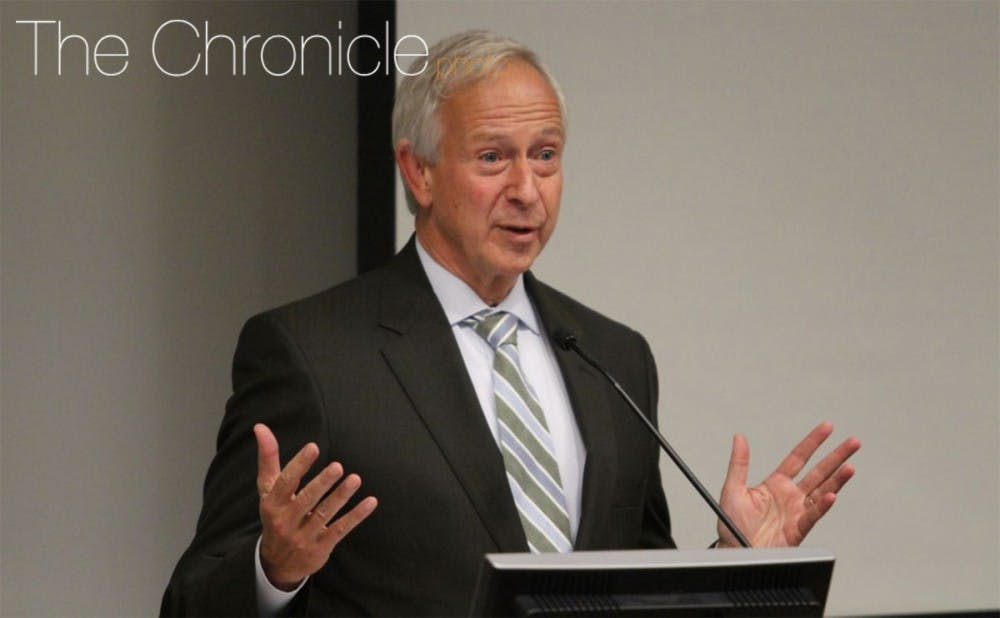Future president Vincent Price has big shoes to fill. The Chronicle took a moment to remember Duke’s former leaders.
Richard Brodhead, 2003-present
Brodhead came to Duke from Yale where he was dean of the College. At Duke, he has overseen a major expansion of the University's global presence with the launch of the Duke-National University of Singapore Graduate Medical School, Duke Kunshan University and the DukeEngage program. The Duke Forward capital campaign, one of his initiatives, has raised more than $3.3 billion to support financial aid, campus construction and innovative academic programming.
Nannerl Keohane 1993-2003
A former president of Wellesley College, Keohane was the first woman to serve as Duke's president and only the second woman to oversee a leading private U.S. research university. During her tenure, the University raised more than $2 billion through the Campaign for Duke, established the Duke University Health System and launched major programs in fields ranging from genomics to ethics.
Keith Brodie, 1985-1993
Brodie, the James B. Duke professor of psychiatry, served as Duke's chancellor from 1982 to 1985 and was named president as Terry Sanford's successor. During his leadership, Duke became a nationally-known research university, established a new school for the environment and built the interdisciplinary Levine Science Research Center. Brodie also established the President's Advisory Council on Resources and started a number of Duke's diversity initiatives.
Terry Sanford, 1969-1985
Affectionately known to all as "Uncle Terry," Sanford was Duke's first president selected from outside the academic community. In his years at Duke, the always approachable former governor oversaw a massive expansion of the physical campus and an increase in participatory governance with the addition of students to campus committees and the Board of Trustees.
Douglas Knight, 1963-1969
Knight served during one of the most chaotic times in Duke and American history, and came into conflict with students on a number of occasions. His tenure, however, included the creation of new undergraduate and medical school curricula, the construction of a hyperbaric chamber, a phytotron and the largest nuclear structure laboratory in the Southeast, as well as a major addition to Perkins Library that increased the library's services and capacity.
Julian Hart, 1960-1963
In his short time as president, Hart overhauled much of the University's administration, creating the Academic Council and redefining the roles of the University Planning Committee and a number of administrative offices. The former chair of the Department of Surgery also amended the University's admissions policy by affirming equality of opportunity regardless of race, creed or national origin.
Arthur Edens, 1949-1960
During the turbulent post-war period for private universities, Edens helped build Duke's endowment. The youngest president in 40 years, the native Southerner also formed the University Council (Academic Council's precursor) and established the James B. Duke Endowed Professorships as well as the student-run Duke University Union. He was also a vigorous defender of academic freedom during the McCarthy Era.
Robert Flowers, 1941-1948
During his more than 60 years at the University, Flowers served in many varied capacities with the presidency being the culminating position. His vast experience and stature were welcome in dealing with the demands of a world at war and the strains of transition to a peacetime economy.
William Few, 1924-1940 (Duke), 1910-1924 (Trinity College)
Greatly respected by students, Few oversaw the institution's transformation from Trinity College into Duke University. A former professor of English and first dean of the College, Few served a 30-year tenure and the University benefitted from the philanthropy of the Duke family.
Get The Chronicle straight to your inbox
Signup for our weekly newsletter. Cancel at any time.

